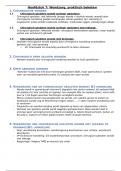Summary
Summary Reading Material Sustainability in Business and Economics
- Module
- Institution
Summary of all the reading material except for the book by Sachs (also available in bundle) for the course 'Sustainability of Business and Economics'. Includes summaries of the Desai chapters, articles and reports that were mandatory reading material in week 1-6 of the course. Comprehensive summary...
[Show more]












